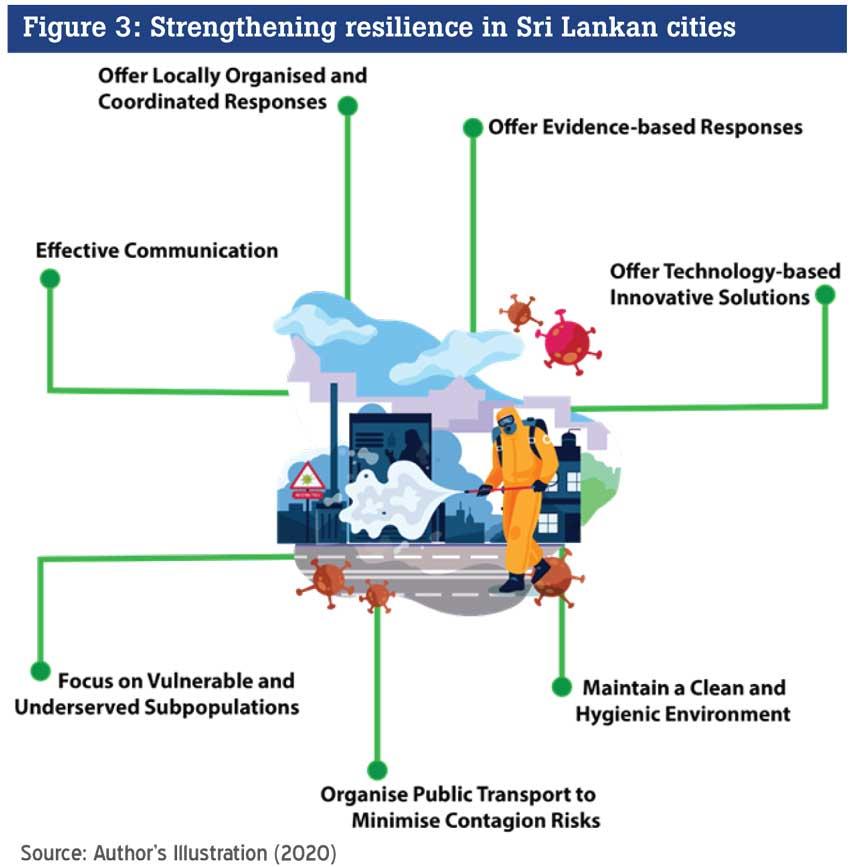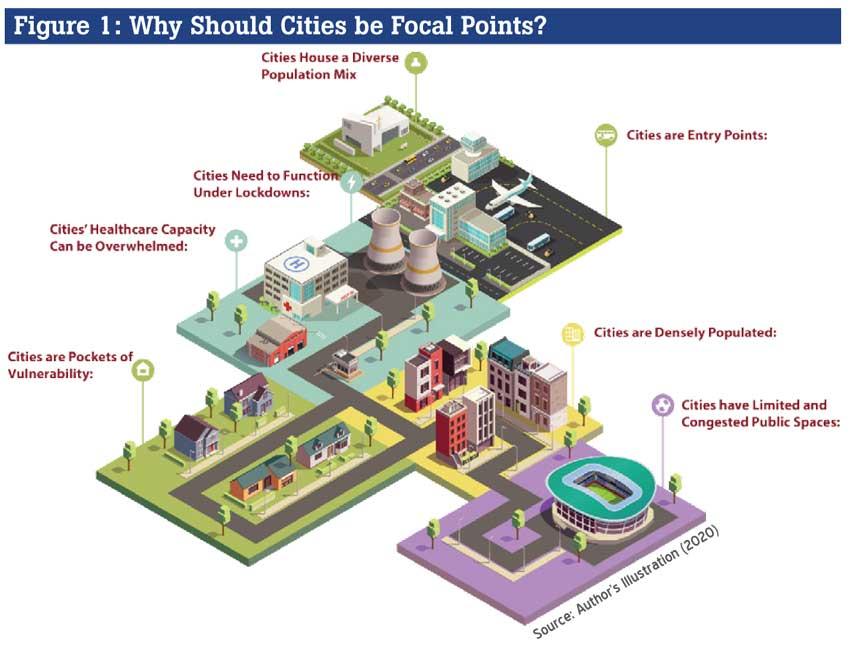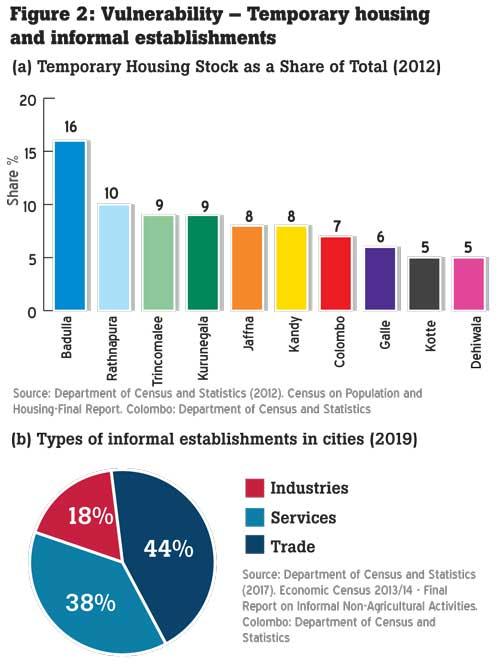20 Nov 2020 - {{hitsCtrl.values.hits}}

 Sri Lanka is experiencing a second wave of the COVID-19 pandemic and cities and urban centres have become the hotspots of vulnerability. With their relatively favourable economic conditions and extensive transport networks, cities attract migrants from rural areas, frequently resulting in overcrowding and greater vulnerability to external shocks such as COVID-19.
Sri Lanka is experiencing a second wave of the COVID-19 pandemic and cities and urban centres have become the hotspots of vulnerability. With their relatively favourable economic conditions and extensive transport networks, cities attract migrants from rural areas, frequently resulting in overcrowding and greater vulnerability to external shocks such as COVID-19.
In fact, over 95 percent of the total reported COVID-19 cases worldwide are in urban areas. Hence, strengthening resilience of cities and urban settlements to meet health emergencies is a critical part of the national response strategy to pandemics.
Cities as focal points
The reasons that cities warrant close attention are as follows
(Figure 1):
Entry points: Transport hubs in cities are entry points to a country and intra and inter-city transport channels are means of disease transmission. According to the National Transport Commission, public transport accounted for 43 percent of the modal share of transport in Sri Lanka in 2017. The total person trips in the Colombo Metropolitan Region is projected to almost double in 2035 and rise to 12.2 person trips per day.
Densely populated: Residential towers, neighbourhood districts and housing schemes are prominent examples of places with high population densities. While this makes strong economic sense and supports better living standards for many, high population densities also make urban residents more susceptible to health emergencies.
Limited and congested public spaces: Recreational parks, supermarkets, amenities like movie theatres and mass gathering spaces for cultural and religious purposes can escalate the spread of disease.

Diverse population mix: The high social and cultural diversity of cities can induce different response patterns and willingness to comply with measures taken to contain health emergencies, in
many circumstances.
Pockets of vulnerability: Cities include urban poor living in informal settlements, homeless people, elderly and people with disabilities and medical conditions that fall under vulnerable groups. Significant shares of urban populations occupy temporary houses (Figure 2.a). Overcrowding, along with undernutrition among children as well as chronic medical conditions in adults, tend to increase infection rates.
Moreover, a large proportion of informal sector employees in Sri Lankan cities dwell in underserved settlements, with around half a million people in the urban sector estimated to be engaged in informal economic activities. Usually, informal sectors in cities are mostly comprised of non-agricultural informal activities (Figure 2.b).
Healthcare capacity can be overwhelmed: City dwellers can face difficulties in accessing limited healthcare facilities due to financial constraints, limited bed numbers and limited availability of specialised healthcare workers.
Need to function under lockdowns: Cities are usually hubs or centres of essential services for national economies. Such characteristics compel cities to be alive, busy and running, even under lockdown conditions.
Building pandemic resilience in SL cities
The above-mentioned reasons make it clear why special attention is necessary for enhancing the preparedness and resilience of cities to mitigate threats posed by pandemics in the future. If ignored, cities can become hot spots for disease transmission. Some areas that require urgent attention are summarised in Figure 3.
Locally organised and coordinated responses: The essential functions of cities should be identified and plans need to be formulated for pandemic management so that hazard preparedness and resilience of cities against pandemics can be enhanced. Planners should review the levels of existing human resources and available facilities and conduct forecasts of future requirements, review existing supply chains and logistic networks and identify alternative channels of logistic facilities.
Continuous monitoring and evaluations of implementation, level of compliance/violations of regulations, etc. should be part of the plan. A coordinated approach between different levels of government and a multi-sectoral approach incorporating sectors like health, social services, transport, housing, education, communication, water and sanitation and waste management should be adopted.
Evidence-based responses: This is one of the crucial factors that will determine the effectiveness of city-level policy responses. Relevant national agencies and local government authorities should carry out risk assessments, prepare profiles and maps of epidemiological risks and identify and implement suitable urban planning and settlement solutions to overcome expected risks based on available evidence.
Vulnerable and underserved sub-populations: Measures to register people engaged in informal livelihoods will help deliver relief without overlaps. The existing transfer payment schemes like ‘Samurdhi’ can have a dual payment strategy where emergency allowances can be topped-up over the base amount during crisis situations. Another alternative is to create a financial facility that offers non-employment benefits for informal sector workers during declared periods of emergency.

Clean environment: Managing waste in cities amid pandemics is crucial. Lessons from South Korea suggest that waste from the infected should be subjected to immediate incineration. Similarly, waste of self-quarantined must be disposed in sanitised bags. Local authorities have to implement quick and efficient training programmes on handling hazardous waste for sanitation workers.
Organise public transport to minimise contagion risks: Adequate measures should be put in place to address congestion in public transport. Maintaining social distance in public modes of transport is always a challenge and working from home and flexible working hours have eased the congestion to a certain extent. More rigorous adjustment of public transport schedules with changes in working hours and traffic management plans, synchronised with revised work-transport schedules, are necessary to address the problem.
Effective communication: The most appropriate means of communication on disease control has to be devised. User-friendly mobile applications can facilitate effective communication and also enable instant updating of information to multi-sector stakeholders, including health workers, civil defence and others.
Technology-based innovative solutions: Automatic doors in buildings, voice-operated or face recognition technology-enabled infrastructure including elevators and doors, exploring the possible applications of drone technology, social distancing facilitated public spaces and a city-wide wireless network for uninterrupted Internet access are possible technology-enabled smart interventions. However, these measures must be carefully designed to ensure that they do not infringe on the citizen’s right to privacy.
Overall, high-quality infrastructure, well-designed institutions and effective interventions strengthened by technology-based solutions will enhance a city’s resilience to potential pandemic outbreaks in the future.
(Ruwan Samaraweera is a Research Assistant at the Institute of Policy Studies (IPS), with a background in entrepreneurial agriculture. He holds a Bachelor’s in Export Agriculture from the Uva Wellassa University. His research interests are in environmental economics, agricultural economics, macroeconomic policy and planning, labour and migration and poverty and development policy. He can be reached at [email protected])
24 Dec 2024 8 minute ago
24 Dec 2024 1 hours ago
24 Dec 2024 2 hours ago
24 Dec 2024 3 hours ago
24 Dec 2024 4 hours ago